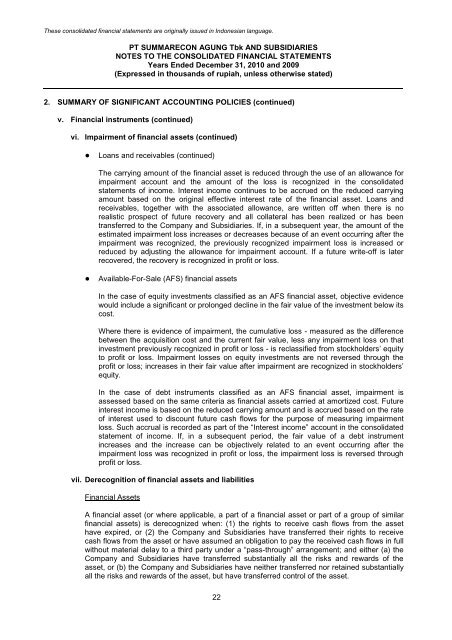PT Summarecon Agung Tbk | Laporan Tahunan 2010 Annual Report
PT Summarecon Agung Tbk | Laporan Tahunan 2010 Annual Report
PT Summarecon Agung Tbk | Laporan Tahunan 2010 Annual Report
You also want an ePaper? Increase the reach of your titles
YUMPU automatically turns print PDFs into web optimized ePapers that Google loves.
These consolidated financial statements are originally issued in Indonesian language.<br />
<strong>PT</strong> SUMMARECON AGUNG <strong>Tbk</strong> AND SUBSIDIARIES<br />
NOTES TO THE CONSOLIDATED FINANCIAL STATEMENTS<br />
Years Ended December 31, <strong>2010</strong> and 2009<br />
(Expressed in thousands of rupiah, unless otherwise stated)<br />
2. SUMMARY OF SIGNIFICANT ACCOUNTING POLICIES (continued)<br />
v. Financial instruments (continued)<br />
vi. Impairment of financial assets (continued)<br />
● Loans and receivables (continued)<br />
The carrying amount of the financial asset is reduced through the use of an allowance for<br />
impairment account and the amount of the loss is recognized in the consolidated<br />
statements of income. Interest income continues to be accrued on the reduced carrying<br />
amount based on the original effective interest rate of the financial asset. Loans and<br />
receivables, together with the associated allowance, are written off when there is no<br />
realistic prospect of future recovery and all collateral has been realized or has been<br />
transferred to the Company and Subsidiaries. If, in a subsequent year, the amount of the<br />
estimated impairment loss increases or decreases because of an event occurring after the<br />
impairment was recognized, the previously recognized impairment loss is increased or<br />
reduced by adjusting the allowance for impairment account. If a future write-off is later<br />
recovered, the recovery is recognized in profit or loss.<br />
● Available-For-Sale (AFS) financial assets<br />
In the case of equity investments classified as an AFS financial asset, objective evidence<br />
would include a significant or prolonged decline in the fair value of the investment below its<br />
cost.<br />
Where there is evidence of impairment, the cumulative loss - measured as the difference<br />
between the acquisition cost and the current fair value, less any impairment loss on that<br />
investment previously recognized in profit or loss - is reclassified from stockholders’ equity<br />
to profit or loss. Impairment losses on equity investments are not reversed through the<br />
profit or loss; increases in their fair value after impairment are recognized in stockholders’<br />
equity.<br />
In the case of debt instruments classified as an AFS financial asset, impairment is<br />
assessed based on the same criteria as financial assets carried at amortized cost. Future<br />
interest income is based on the reduced carrying amount and is accrued based on the rate<br />
of interest used to discount future cash flows for the purpose of measuring impairment<br />
loss. Such accrual is recorded as part of the “Interest income” account in the consolidated<br />
statement of income. If, in a subsequent period, the fair value of a debt instrument<br />
increases and the increase can be objectively related to an event occurring after the<br />
impairment loss was recognized in profit or loss, the impairment loss is reversed through<br />
profit or loss.<br />
vii. Derecognition of financial assets and liabilities<br />
Financial Assets<br />
A financial asset (or where applicable, a part of a financial asset or part of a group of similar<br />
financial assets) is derecognized when: (1) the rights to receive cash flows from the asset<br />
have expired, or (2) the Company and Subsidiaries have transferred their rights to receive<br />
cash flows from the asset or have assumed an obligation to pay the received cash flows in full<br />
without material delay to a third party under a “pass-through” arrangement; and either (a) the<br />
Company and Subsidiaries have transferred substantially all the risks and rewards of the<br />
asset, or (b) the Company and Subsidiaries have neither transferred nor retained substantially<br />
all the risks and rewards of the asset, but have transferred control of the asset.<br />
22


